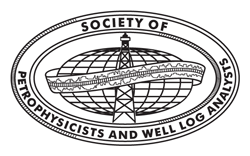
VINICIUS MACHADO, PAULO FREDERICO and PAULO NETTO, Petrobras; RODRIGO BAGUEIRA, Fluminense Federal University, Brazil; AUSTIN BOYD, ANDRE SOUZA, LUKASZ ZIELINSKI and ELMAR JUNK, Schlumberger
Well-established methodology exists to evaluate carbonate lithology, porosity, pore types, permeability and saturation in wells drilled with water-based fluids. These techniques can be adapted for applications where oil-based mud must be used, such as Brazil’s presalt formations.
Several classification schemes have been developed to aid formation evaluation in carbonates, based on quantifying carbonate rock texture by either by grain size,1–2 pore-size3–5 or pore-throat size.6–7 These schemes were developed from visual inspection of cores and cuttings, thin-section microscopy or mercury porosimetry. Recent advances in nuclear magnetic resonance (NMR) log and core analysis, complemented by more quantitative use of borehole image logs, has led to the application of log-based porosity partitioning based on some of these models. The foundation of this approach is the link between NMR transverse relaxation time (T2) distributions and pore-size distributions obtained from special core analysis. Several case studies have now been presented where this approach was successfully used in carbonate formations drilled with water-based mud (WBM), where the NMR response is well characterized and has been validated by core analysis.
The recently discovered carbonate reservoirs offshore Brazil are typically drilled with oil-based mud (OBM) to avoid problems in the 6,500 ft of salt overlying the reservoir. NMR logs are routinely run in the reservoir section, and it has been demonstrated that the interpretation methods developed for carbonates drilled with WBM can be adapted for OBM applications. The tendency of these carbonates to be oil-wet to both the 28–30°API reservoir oil and the OBM filtrate ensures that surface relaxivity is the dominant relaxation mechanism in the NMR response, which enables the correlation of T2distributions with the variety of pore sizes in the reservoir zones. Interpreting NMR logs under such conditions requires detailed knowledge of the OBM filtrate properties, the reservoir oil properties and the wettability of the formation at downhole conditions.
Comparison of downhole NMR log data with lab measurements performed on native-state, restored-state, brine-saturated and partially saturated cores shows that many of these carbonate classification schemes can be applied in the presalt carbonates. This article examines the common features of these schemes and reviews the various models in terms of their relevance for formation evaluation in the presalt carbonates. Options for analyzing borehole image logs in carbonates drilled with OBM are also presented as an aid to porosity typing with NMR.
INTRODUCTION
Ever since the initial presalt discovery well drilled at Tupi (now Lula) field in 2007, NMR logs have been run routinely in the presalt carbonate reservoirs offshore Brazil. The NMR logs are used for lithology (independent porosity), for estimation of irreducible water saturation and as an indication of reservoir quality based on the T2 distribution spectra. When surface relaxivity dominates the response, the T2 distributions are often viewed as analogous to pore-size distributions. Several researchers have also highlighted the correlation of T2 distributions to pore-throat histograms from mercury porosimetry8 and grain-size histograms.9 Most petrophysical classification schemes for carbonates are based on quantifying grain size, pore size or pore-throat size.
When micro- and meso-porosity are the dominant porosity types, surface relaxivity should dominate the NMR response and the well-established NMR permeability equation, based on the log mean of T2 distributions (T2lm, in s), and porosity should be valid for estimating permeability. In its modified form, more appropriate for carbonates, we have:
 Eq. 1 Eq. 1
where KSDR is permeability (in mD), A is a pre-multiplier, ϕ is the porosity fraction (in porosity units, or pu), C is the porosity exponent (usually between 2 and 4), ρ is the surface relaxivity (in microns/s) and B is the exponent for T2lm (usually 2). The pre-multiplier A is traditionally set to 4 in sandstones and 0.4 in carbonates, to account for the difference in surface relaxivity. In the high-porosity carbonates of the Middle East where porosity varies little, changing the porosity exponent C from 4 to 2 can improve the result by lowering the dynamic range due to porosity variation and, thus, putting more weight on T2lm for estimating permeability. In carbonates where porosity varies considerably, though, it is usually best to keep the exponent at 4. The value for ρ typically varies from 1 to 3 microns/s in most carbonates, and can actually be influenced by the type of fluid that is saturating and wetting the formation, as discussed below. Traditionally, this value was incorporated into A, but introducing surface relaxivity as a separate term allows an option for accounting for changes in surface relaxivity without changing the pre-multiplier. The exponent B for the term ρT2lm is normally set to 2, as this term is considered the equivalent of the pore radius and permeability is expected to vary with the square of the pore radius.
When macro-porosity is significant, typically 2 pu or more, T2lm loses sensitivity to the size of macro-pores but not the volume of macro-porosity. To account for this change, a new equation is used that incorporates the ratio of macro-porosity to micro- and meso-porosity:
 Eq. 2 Eq. 2
where KMACRO is the permeability (in mD), VMACRO is the macro-porosity as determined from NMR partitioning, and B is the exponent for the porosity ratio.
The parameters are usually adjusted to align KMACRO with KSDR when vuggy porosity is less than 2 pu. One of the most sensitive parameters is the T2 cutoff used to partition the macro-porosity, discussed below.
CARBONATE POROSITY PARTIONING
Figure 1 illustrates the use of NMR T2 distributions and image log analysis for porosity partitioning in carbonates10 into micro-, meso- and macro-porosity by applying cutoffs. This approach assumes that the T2 distribution will have a reasonable correspondence with the pore size distributions, and that no hydrocarbon effects are distorting the T2 distribution. In carbonates drilled with OBM, this assumption requires investigation.
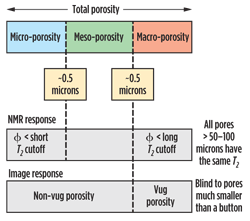 |
| Fig. 1. Pore space partitioning6 as implemented on borehole log data.11 |
|
For image logs, deriving the vuggy or macro-porosity from histograms of the electrical image is a long-established procedure in wells drilled with WBM. Recent tool design advances have enabled the use of electrical image logs in OBM as well, and this methodology is being tested in the presalt carbonates. Preliminary results indicate that this approach can be used provided that formation resistivity is higher than mud resistivity. In the reservoir sections of the presalt wells, this is usually the case. A similar approach is also being evaluated for extracting vuggy porosity from amplitude histograms of acoustic image logs. Acoustic amplitude is lower in vugular intervals, and efforts are underway to validate this approach through comparison to core.
The methodology shown in Fig. 1 assumes four conditions with regard to extracting the three porosity types from NMR T2 distributions:
-
There is minimal diffusive coupling between the three porosity types.
-
There is no significant diffusion effect shortening the bulk T2 components.
-
The bulk T2 is at least 1 s or longer.
-
Surface relaxivity is the dominant mechanism over the micro- to meso-porosity range.
Examining these conditions for carbonates drilled with OBM, where the reservoir oil is typically less than 2 cP at downhole conditions, it is observed that using OBM can actually be advantageous compared with WBM for porosity typing using NMR T2 distributions. Analysis of carbonate micro-porosity suggests that it contains irreducible water, and only contains oil when located more than 1,100 ft above the oil-water contact.7 When this is the case, no diffusive coupling is expected between the oil in meso- and macro-pores and the water in micro-pores. Likewise, if the OBM filtrate is only invading the meso- and macro-pores, no diffusive coupling is expected between the micro-porosity and the meso- and macro-pores. Diffusive coupling between the micro-porosity and meso- and macro-porosity in carbonates drilled with WBM12,13 can affect NMR interpretation in carbonates. It complicates the use of NMR logs for determining irreducible water saturation and estimating permeability. Analysis of the presalt carbonates indicates that diffusive coupling is not a significant issue and Condition 1 is satisfied.
Condition 2, regarding diffusion effects on the long T2 components, is satisfied by ensuring that the NMR logs are acquired at a short enough echo spacing (typically 200 ms) to prevent diffusion from shortening the long T2 components. A short echo spacing also ensures more accurate micro-porosity and total NMR porosity. Condition 3, regarding a bulk T2 of 1 s or more, is satisfied because both the OBM filtrate and the presalt reservoir oil have bulk T2 at downhole conditions ranging 1–3 s. Condition 4, that surface relaxivity is the dominant mechanism for the micro- and meso-pores, is satisfied because there is strong evidence that both the reservoir oil and the OBM filtrate are wetting the formation meso- and macro-pores. The micro-pores are assumed to be water-filled and water-wet.
Most carbonate formations have surface relaxivities in the range of 1–3 microns/s.14 Assuming a surface relaxivity of 3 microns/s, no significant shift in T2 due to diffusion, and that the saturating fluid is fully wetting the formation, we can correlate T2 to pore size using the equation:15
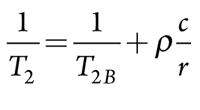 Eq. 3 Eq. 3
where T2B is the bulk T2 of wetting fluid (in s), c is the constant for pore shape (3 for spherical pores, 2 for cylindrical pores and 1 for planar pores, based on the surface-to-volume ratio), and r is the pore radius (in microns). Assuming cylindrical pores and varying T2B between 1 s and 3 s, the micro- and meso-pores can be seen to have a direct relationship to T2 when plotted on a log-log scale, whereas the macro-pores have lost sensitivity to T2, Fig. 2. The volume of macro-porosity is still valid as the integration of T2 relates to porosity, but the relation between pore radius and T2 is no longer valid.
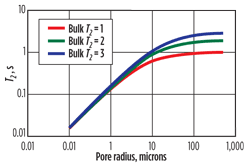 |
| Fig. 2. Effect of bulk T2 on the relationship between T2 and pore size, assuming ρ of 3 microns/s, cylindrical pores and that the saturating fluid is wetting the formation. |
|
This is the fundamental reason that estimating permeability in carbonates based only on T2 and porosity (KSDR) has limited dynamic range and why the method shown in Fig. 1 is more appropriate in zones where macro-porosity is significant. To compensate for the lack of sensitivity between pore size and T2 for macro-pores, the KMACRO permeability transform is used when macro-porosity exceeds a threshold, typically 2 pu. Past this threshold, the relationship between KMACRO and the ratio of macro-porosity to total porosity shows a log-linear trend with permeability until macro-porosity exceeds 80% of total porosity. It must be emphasized that both permeability transforms assume connectivity of the pores. This approach is not intended for use in cases where the macro- or vuggy porosity is significantly isolated.
WETTABILITY AND NMR RESPONSE
Special core analysis (SCAL) is the industry standard for determining formation wettability. Core-flooding experiments are underway for selected presalt cores, but no results are available to date. However, there are indications that the presalt carbonates are oil-wet, based on high Archie saturation exponent (n) measurements, high resistivity log profiles in the reservoir section, and comparisons between the bulk T2 and NMR T2 distributions acquired with wireline logs. The amount of shift to faster relaxation times when comparing T2 distributions of partial saturated initial water saturation (Swi) cores with the bulk oil response of the saturating oil is an excellent indicator of wettability, and compares well with SCAL results.15
In Fig. 3, the black dotted line shows the lab NMR T2 distribution for an OBM filtrate sample measured at 172°F. The sample was obtained by centrifuging 1 L of OBM for 24 hr and then skimming the lighter fluid from the top of the sample. Conventional mud press filters are not practical for obtaining sufficient volume of filtrate for core partial-saturation studies.
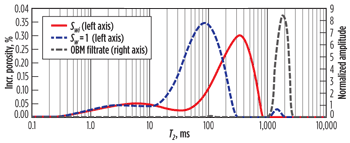 |
| Fig. 3. Lab NMR T2 distribution of OBM filtrate, 100% brine-saturated core and core saturated by both brine (Swi) and OBM filtrate. |
|
The OBM filtrate was then centrifuged into a brine-saturated presalt carbonate core sample. The blue dotted and red lines in Fig. 3 show the lab NMR results for the core at 100% brine saturation (Sw = 1), and for the core when it is partially brine saturated (Swi) and partially saturated by OBM filtrate, respectively. All core measurements were taken at reservoir temperature of 178°F, with similar lab NMR acquisition parameters. The pronounced shift to shorter relaxation time between the bulk T2 response and the Swi response is typical in carbonates and is a strong indication that the OBM filtrate is wetting the grains in the meso- and macro-pores. The general overlay of the T2 distributions in the micro-porosity indicates that the micro-pores have remained water-saturated and, thus, are still water-wet. This is an important result, as it validates the use of micro-porosity as an indication of Swi on the log and, thus, Sw in the reservoir section, where the extremely high resistivity values and uncertainty about the saturation exponent (n) add uncertainty to any Sw calculations based on resistivity logs.
Another important observation is the shift of the T2 peak for the meso-porosity where it increases from about 100 ms at Sw = 1 to 300 ms at Swi. This shift by about a factor of 3 is typical behavior for oil-wet cores at Swi conditions, as the surface relaxivity for the oil-wet case (Swi) is less than the surface relaxivity for the water-wet case (Sw = 1).15 The implication is that the surface relaxivity for the oil-wet case is one-third the surface relaxivity for the water-wet case. This effect may necessitate an increase in the cutoff between meso- and macro-porosity for the oil-wet case compared with the water-wet case.
However, in most circumstances this cutoff is more dependent on the bulk T2 of the wetting and saturating fluid than on the surface relaxivity. Figure 4 shows the response for T2 vs. pore size for cylindrical pores at ρ = 3 (water-wet) and ρ = 1 (oil-wet). When the pore size trends toward macro-porosity (30 microns), the effect of surface relaxivity diminishes as the bulk T2 effect dominates. This implies that the T2 cutoff for macro-porosity can be similar for the oil-wet case and the water-wet case if each fluid has a similar bulk T2. In most cases, though, the oil and water will have different bulk T2 values and the T2 cutoff for macro-porosity will be different.
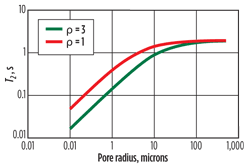 |
| Fig. 4. Simulation of T2 and cylindrical pore radius for brine-saturated and oil-saturated cases at bulk T2 = 2 s. |
|
Further building on the relationship between bulk T2 and ρ, it is possible to simulate what to expect at Swi conditions where OBM filtrate is saturating and wetting the macro- and meso-pores while the micro-pores remain brine-saturated and -wetted. At reservoir conditions, the brine has a bulk T2 value of 1.2 s and the surface relaxivity of the micro-pores is assumed to be 3 microns/s. Since the meso- and macro-pores are wetted by and saturated with OBM filtrate, their effective surface relaxivity is 1 micron/s and the bulk T2 of the OBM filtrate is 2 s.
Figure 5 shows the response of T2 vs. pore size for cylindrical pores for ρ = 3 microns/s and ρ = 1 micron/s. The micro-pores are water-wet and water-saturated for both cases. The meso-porosity response changes significantly due to the change in effective ρ as the meso-pores change from water-saturated and water-wet to oil-saturated and oil-wet. This increase in T2 is due to the change in effective ρ rather than the change in bulk T2. For the macro-pores, the change between the water-saturated, water-wet case and the oil-saturated, oil-wet case is more strongly related to the change in bulk T2 than to the change in effective ρ.
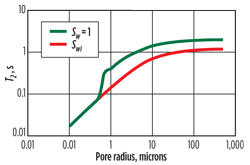 |
| Fig. 5. Simulation of T2 and cylindrical pore radius for a brine-saturated, water-wet case and an oil-brine (Swi), mixed-wet case. |
|
The key point of this analysis is that surface relaxivity dominates the NMR response for micro- and meso-pores for both water-wet and oil-wet cases, and bulk relaxivity dominates the response for the macro-porosity for both cases. This implies different T2 cutoff values for porosity partitioning between the oil-wet and the water-wet scenarios. For the micro- to meso-porosity cutoff, it will depend on the degree of oil-wettability of the meso-pores and the resulting effect on surface relaxivity. For the meso- to macro-porosity cutoff, it will depend more on the contrast in bulk surface relaxivity of the brine and either the reservoir oil or the invading OBM filtrate.
Additional confirmation that the formation is oil-wet is obtained by comparing the NMR log data with the lab NMR data, acquired at downhole temperature. The comparison shows close agreement between the core sample at Swi conditions (with brine and OBM filtrate) and the T2 distribution from the NMR log at the same depth, Fig. 6.
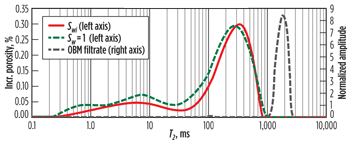 |
| Fig. 6. Comparison of log NMR T2 distribution with the distribution for a core sample at Swi conditions. |
|
It is difficult to say whether the log is responding to the OBM filtrate invading the formation or to the reservoir oil, or to a combination of both. It does appear, though, that whichever fluid the NMR log is responding to is wetting the formation; thus, the T2 response is an indication of pore size distribution.
POROSITY TYPING FROM IMAGE LOGS
Vug porosity is routinely extracted from borehole images in WBM by converting the resistivity image into a porosity image and creating a porosity histogram over a short interval around the borehole. Vugs, being conductive, will generate high-porosity events on the histogram, and a porosity threshold is applied to quantify the vug porosity. In terms of carbonate porosity partitioning, vugs represent macro-porosity, as has been verified experimentally.16
In OBM, newly modified electrical borehole image logging tools can acquire images that clearly indicate vugs, fractures and bedding. When formation resistivity is higher than the mud resistivity, vuggy porosity can be estimated by applying a cutoff to a histogram of conductivity from the electrical image log. For acoustic image logs, the amplitude of the images will vary inversely with porosity, and low amplitudes generally correlate with vuggy zones. Electrical image logs have higher vertical resolution (0.2 in.) than acoustic image logs (0.4 in.), but acoustic images have 100% borehole coverage.17 The availability of electrical borehole images in wells drilled with OBM should lead to a combined electrical-acoustic image interpretation methodology for evaluating vuggy porosity.
ACKNOWLEDGMENTS
This article was prepared from Paper B presented at the SPWLA 52nd Annual Logging Symposium held in Colorado Springs, Colorado, May 14–18, 2011. The authors thank Flora Marques (Schlumberger BRGC), David Johnson (Schlumberger-Doll Research) and Arnout Colpaert (Statoil) for their assistance and advice with effective medium modeling for carbonate acoustics; Edmilson Rios (National Observatory, Rio de Janeiro) for his assistance with lab NMR measurements; and Wave Smith (Schlumberger-Doll Research) for his expertise with carbonate core preparation.
LITERAUTRE CITED
1 Archie, G. E., “Classification of carbonate reservoir rocks and petrophysical considerations,” AAPG Bulletin 36, No. 2, 1952, pp. 21.
2 Lucia, F. J., “Rock-fabric/Petrophysical classification of carbonate pore space for reservoir characterization,” AAPG Bulletin 79, No. 9, 1995, pp. 26.
3 Choquette and Pray, “Geologic nomenclature and classification of porosity in sedimentary carbonates,” AAPG Bulletin, 1970.
4 Pittman, E., “Microporosity in carbonate rocks,” AAPG Bulletin 55, No.10, 1971.
5 Cantrell and Haggerty, “Microporosity in Arab formation carbonates, Saudi Arabia, GeoArabia,” Vol. 4, No. 2, 1999.
6 Marzouk, I., Takezaki, H. and M. Miwa, “Geologic controls on wettability of carbonate reservoirs, Abu Dhabi, U.A.E.,” SPE 29883 presented at SPE Middle East Oil Show, Bahrain, March 11-14, 1995.
7 Clerke, E., “Permeability, relative permeability, microscopic displacement efficiency, and pore geometry of M-1 bimodal pore systems in Arab D limestone,” SPE 10529, 1999.
8 Lowden, Benjamin D., Porter, and J. Matthew, “T2 relaxation time versus mercury injection capillary pressure: Implications for NMR logging and reservoir characterisation.” SPE 50607-MS, 1998.
9 Chen J., Chen, S. and M. Gladkikh, “Method of determining formation grain size distribution from acoustic velocities and NMR relaxation time spectrum,” 49th Annual Logging Symposium, Austin, Texas, May 25 - 28, 2008.
10 Hassall, J., Ferraris, P., Al-Raisi, M., Hurley, N.F., Boyd, A., and D.F. Allen, “Comparison of permeability predictors from NMR, formation image and other logs in a carbonate reservoir,” SPE 88683 presented at the 11th Abu Dhabi International Petroleum Exhibition and Conference, Abu Dhabi, U.A.E., October 10-13, 2004.
11 Ramamoorthy, R., Boyd, A., Neville, T., Seleznev, N., Sun, H., Flaum, C, and J. Ma, “A new workflow for petrophysical and textural evaluation of carbonate reservoirs,” Paper B presented at the SPWLA 49th Annual Logging Symposium, Edinburgh, Scotland, May 25-28, 2008.
12 Ramakrishnan, T.S., Ramamoorthy, R., Fordham, E., Schwartz, L., Herron, M., Saito, N. and A. Rabaute, “A model-based interpretation methodology for evaluating carbonate reservoirs,” SPE 71704 presented at the SPE Annual Technical Conference and Exhibition, New Orleans, LA, USA, Sept. 30 – Oct. 3, 2001.
13 Anand, V. and G. Hirasaki, “Diffusional coupling between micro and macroporosity for NMR relaxation in sandstones and grainstones,” Petrophysics Vol 48, No 4, Aug 2007.
14 Kleinberg, R.L., “Utility of NMR-T2 distributions, connection with capillary pressure, clay effect, and determination of surface relaxivity parameter, from Magnetic Resonance Imaging,” Elsevier, Vol. 14 – No. 7/8, 1996, pp. 761 – 767.
15 Looyestijn, W. and J. Hofman, “Wettability index determination by nuclear magnetic resonance,” SPE 93624 presented at 14th SPE Middle East Oil & Gas Show, Bahrain, March 12-15, 2005.
16 Gomaa, N., Al-Alyak, A., Ouzzane, D.E., Saif, O., Okuyiga, M., Allen, D.F., Rose, D., Ramamoorthy, R., and E. Bize, “Case study of permeability, vug quantification and rock typing in a complex carbonate,” SPE 102888 presented at the SPE Annual Technical Conference and Exhibition, San Antonio, Texas, Sept. 24-27, 2006.
17 Hurley, N.F., Zimmerman, D and D. Pantoja, “Quantification of vuggy porosity in a dolomite reservoir from borehole images and core, Dagger Draw field, New Mexico,” SPE 49323 presented at SPE ATCE, New Orleans, Louisiana, 1998.
ADDITIONAL BIBLIOGRAPHY
Baechle, G. Colpaert, A., Eberli, G. and R. Weger, “Modeling carbonate pore structure effects on velocity using a dual porosity DEM theory,” SEG 76th Annual Meeting, San Antonio, Texas, 2007.
Brie, A., Johnson, D. L. and R. Nurmi, “Effect of spherical pores on sonic and resistivity measurements,” SPWLA 26th Annual Logging Symposium, June 17 - 20, 1985.
Formigli, J. Pinto, A., and A. Almeida, “Santos basin’s presalt reservoirs development- The way ahead,” SPE-OTC 19953 presented at OTC, Houston, Texas, May 4-7, 2009.
Gyllensten, A., Al-Hammadi, M.I., Abousrafa, E., Boyd, A., Ramamoorthy, R., Neumann, S., and T.J. Neville, “A new workflow for comprehensive petrophysical characterization of carbonate reservoirs drilled with water-base muds,” SPE118380 presented at the Abu Dhabi International Petroleum Exhibition and Conference, Abu Dhabi, UAE, Nov. 3-6, 2008.
Ramamoorthy, R. and W.F. Murphy III, “Fluid identification through dynamic modulus decomposition in carbonate reservoirs,” SPWLA 39th Annual Logging Symposium, Keystone, Colorado, June, 1998.
THE AUTHOR
|
| VINICIUS MACHADO is the Manager of Core Analysis at Petrobras’ Cenpes R&D center in Rio de Janeiro. He holds a joint MSc degree from the Federal University of Rio de Janeiro and the University of Texas at Austin, and joined Petrobras in 2002. |
PAULO FREDERICO is an NMR Scientist for Petrobras’ Cenpes R&D center. He holds an MSc degree from Fluminense Federal University (UFF), Brazil, and joined Petrobras in 2004. |
PAULO NETTO is a Geologist/Petrophysicist for Petrobras, based in Rio de Janeiro. He joined the company in 2004 after receiving a BSc in geology from the State University of Rio de Janeiro. Mr. Netto served as President of SPWLA Brazil in 2009–2010. |
RODRIGO BAGUEIRA is a chemistry professor at UFF. He holds MSc and PhD degrees in analytical chemistry from the University of Sao Paulo, and worked at Cenpes from 2002 to 2004. |
AUSTIN BOYD is the Petrophysics Program Manager at Schlumberger’s Brazil Research and Geoengineering Center in Rio de Janeiro. He previously served as Program Manager for Petrophysics at Schlumberger-Doll Research. Mr. Boyd joined Schlumberger in 1981 as a field engineer after receiving a BSc degree in electrical engineering from Dalhousie University in Halifax, Nova Scotia. |
ANDRE SOUZA is a Research Associate at Schlumberger’s Brazil Research and Geoengineering Center. He holds an MSc degree in materials science and engineering from the University of Sao Paulo, where he is studying for his PhD. Mr. Souza joined Schlumberger in 2010 as an intern at Schlumberger-Doll Research. |
|
LUKASZ ZIELINSKI is a Senior Research Scientist at Schlumberger-Doll Research in Cambridge, Massachusetts. He joined Schlumberger in 2003 after receiving his PhD in physics from Harvard University. |
ELMAR JUNK is Schlumberger’s Wireline Petrophysics Domain Champion for Brazil, based in Macae. He has held a variety of positions in operations and interpretation in the US, Latin America and Europe. Mr. Junk joined Schlumberger in 1988 as a field engineer after receiving his MSc degree in geology from Phillips University in Marburg, Germany. |
|


 Eq. 1
Eq. 1 Eq. 2
Eq. 2
 Eq. 3
Eq. 3





